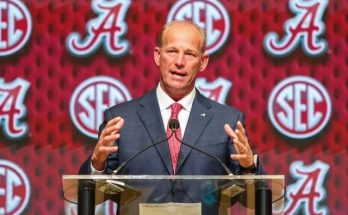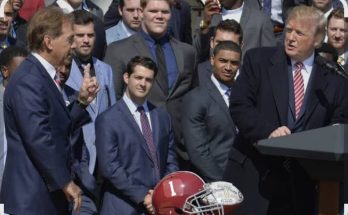The 2024-25 Alabama Crimson Tide men’s basketball team did not hoist the national championship trophy at season’s end, but to define the year in any terms other than a resounding success would be to miss the bigger picture. In one of the most competitive eras of college basketball, where parity reigns and March is as unpredictable as ever, Alabama broke through historic barriers, redefined its program identity, and sent a thunderous message to the national stage: the Tide is here to stay.
For decades, Alabama basketball stood in the long shadow of its gridiron counterpart. Despite flashes of promise and regional success, national relevance was fleeting. That all changed under head coach Nate Oats, who has taken the Crimson Tide from SEC upstart to national contender in just a few years. The 2024-25 season didn’t simply sustain that growth — it escalated it. From Final Four history to elite player development, this team delivered in every measurable way except for one: winning it all. And even that should not overshadow what they achieved.
Breaking the Barrier: First Final Four in School History
Let’s start with the headline: for the first time in the program’s storied, yet underwhelming basketball history, Alabama reached the Final Four. That milestone alone places this team in a class of its own. The Tide had flirted with deep runs in recent years — most notably the 2020-21 team that reached the Sweet 16 — but could never quite get over the hump. This season, they did.
The road wasn’t easy. Alabama faced stiff competition from both its conference rivals and national opponents. A grueling SEC schedule, complete with dogfights against Tennessee, Auburn, and Kentucky, forged a resilient unit that was ready for the demands of March. The NCAA Tournament saw the Tide topple seasoned programs, including a gritty Elite Eight win over a battle-tested Houston squad. By the time Alabama reached the Final Four, they weren’t just Cinderella; they were giants in their own right.
The victory meant more than just cutting down nets — it was a cultural shift. For the first time, Alabama basketball wasn’t playing to exceed expectations — it was the expectation. The national media took notice. Recruits took notice. And perhaps most importantly, the fans did too.
Nate Oats: The Architect of a New Era
Any discussion of Alabama’s success must begin with head coach Nate Oats. Since arriving in Tuscaloosa in 2019, Oats has done more than win games. He has established a program identity: fast-paced, analytics-driven offense paired with an aggressive defensive mindset. His commitment to playing modern basketball — spacing the floor, shooting threes, attacking mismatches — has turned the Crimson Tide into one of the most dangerous teams in the country.
This season, Oats refined that formula. While Alabama still played with tempo, they demonstrated greater poise in late-game situations, stronger defensive discipline, and an increased ability to win when the three-ball wasn’t falling — an Achilles’ heel in previous years. It’s a testament to Oats’ growth as a coach and leader.
He also continues to show remarkable prowess in the transfer portal, combining high school recruiting with strategic veteran additions. Oats didn’t just reload — he reengineered. That ability to adapt and sustain success is what separates good coaches from great ones.
Star Power and Player Development
Central to Alabama’s rise was its talent — both in terms of raw ability and how it evolved throughout the season. Mark Sears, the senior guard and emotional leader, was the linchpin. His scoring ability, court vision, and defensive energy were unmatched. Sears elevated his game in March, averaging over 20 points per contest during the tournament and making clutch play after clutch play. His name will be etched into Crimson Tide lore forever.
But it wasn’t just Sears. Forward Grant Nelson provided toughness and rebounding in key moments, while freshman Jarin Stevenson blossomed into a future star. The balance between veteran leadership and youthful upside was crucial. Role players like Rylan Griffen and Latrell Wrightsell Jr. made critical contributions on both ends of the floor, showing the depth of the roster.
Player development, another hallmark of Oats’ tenure, was evident throughout. Several players made significant year-over-year leaps, with improved shooting mechanics, decision-making, and defensive versatility. It’s one thing to recruit stars — it’s another to maximize them. Alabama did both.
Navigating Adversity
No championship-level team gets through a season without adversity, and the Crimson Tide had their share. Injuries, tough road environments, and a midseason losing skid tested the team’s resolve. Critics questioned their defense at times. Others wondered whether the team relied too much on perimeter shooting.
But each time doubt crept in, Alabama responded. They tightened rotations. Adjusted schemes. And above all, kept their composure. By March, they were battle-hardened. That mental toughness — a byproduct of a relentless schedule and a culture of accountability — served them well in the tournament gauntlet.
It’s also worth noting the off-court pressures that come with being at the helm of a surging program. The scrutiny is real. Yet Alabama’s players and staff handled the spotlight with maturity and professionalism, never letting the moment become too big.
National Recognition and Program Prestige
By season’s end, Alabama was no longer a team you “had to respect” — they were a brand. National television appearances became the norm. NBA scouts filled the stands. Nate Oats’ name was floated in every major coaching vacancy conversation (though he reaffirmed his commitment to Tuscaloosa).
The program’s visibility soared. ESPN featured Alabama as a “modern-day model” for building a successful basketball program in a football-first school. The university saw a spike in merchandise sales and applications. What Nick Saban did for Alabama football, Nate Oats is beginning to do for basketball — and that’s no exaggeration.
This surge in prestige has tangible benefits. Recruiting will only improve. The transfer portal becomes more attractive. And most importantly, expectations are reset. Alabama is no longer hoping for a good year. It’s building a dynasty.
The Fanbase Awakens
For years, Coleman Coliseum struggled to create the same electric environment found in places like Rupp Arena or the Dean Dome. That changed this season. Sellouts became common. The student section was relentless. “Roll Tide” chants echoed deep into March.
Basketball finally took center stage — and the fans loved it. There was a palpable sense of pride, not just in what the team was doing, but in what it represented: a new chapter for Alabama sports. The Tide is no longer a one-sport school, and the fanbase has rallied accordingly.
Room to Grow: Building on the Foundation
Does Alabama have room to improve? Absolutely. The program is still chasing its first national championship. Defensive consistency remains a work in progress. Depth could always be better. But those critiques don’t diminish the magnitude of what was accomplished.
The best part? This doesn’t feel like the end. It feels like the beginning.
Oats has already landed a top-15 recruiting class for next season. Several key players are eligible to return, and the transfer portal offers a chance to further bolster the roster. The infrastructure is in place — training facilities, NIL support, coaching continuity. Everything necessary to stay elite.
Legacy of the 2024-25 Team
Years from now, Crimson Tide fans will look back at this team as the one that broke through. The one that showed it could be done. The one that turned potential into production, hype into hardware.
Their legacy is not defined solely by their Final Four banner — though that banner will hang proudly — but by the cultural transformation they sparked. Alabama basketball is no longer a side note. It’s a headline.
This team won’t be forgotten because it changed what people thought was possible.
Final Thoughts: A Season to Celebrate
In college basketball, only one team finishes with a win. For everyone else, it’s about how the journey reshaped the program. By every possible measure — historic milestones, player development, national relevance, and fan engagement — Alabama’s 2024-25 campaign was a spectacular success.
To those who point to the lack of a championship, remember: greatness is a process. Foundations are laid over time. The teams that hang banners are the ones who first build belief. This team did that.



